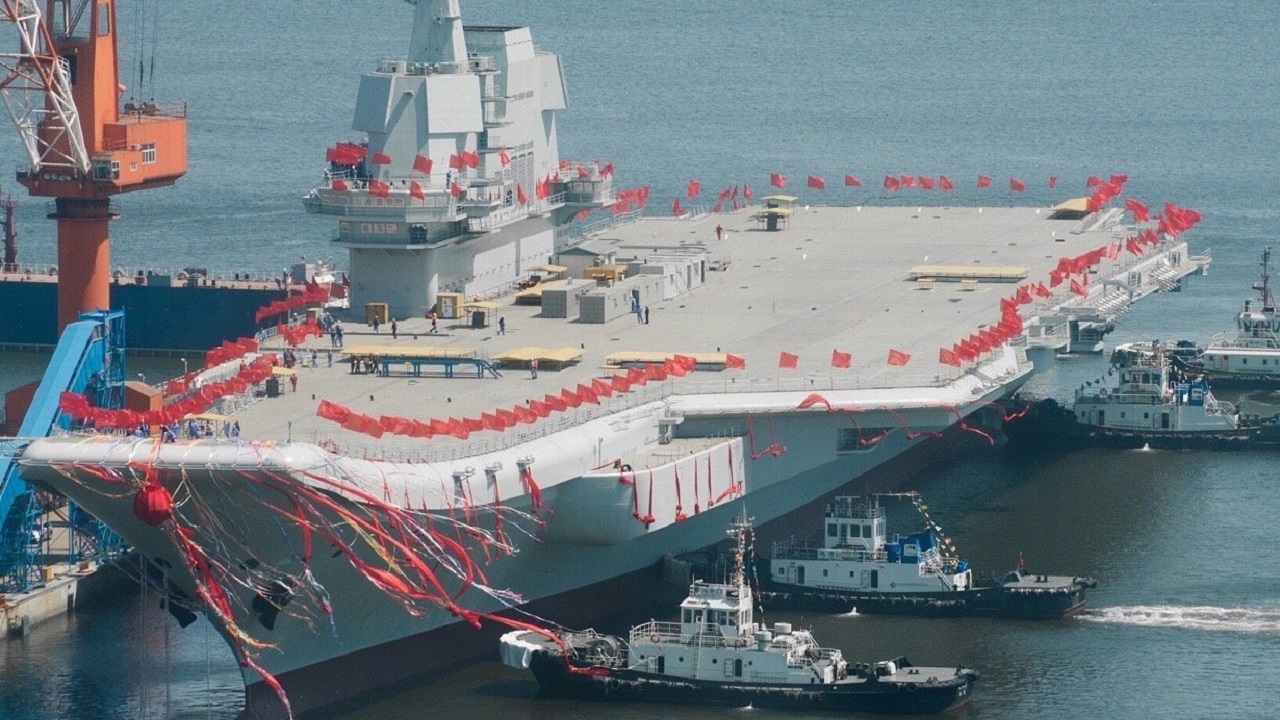Eagle-eyed viewers on social media recently spotted what appeared to be two cracks on the flight deck of the still-under-construction flight deck of the People’s Liberation Army Navy (PLAN) Type 003 aircraft carrier Fujian.
The second domestically-built Chinese aircraft carrier was launched last year and is currently fitting out.
The warship is expected to have an expanded carrier air wing and will utilize electromagnetic catapults to launch aircraft rather than the ski jump employed on past PLAN carriers.
Cracks Apparent?
According to social media posts, satellite images taken of the Fujian as it is still under construction, appeared to show a pair of cracks that ran about two meters long across the flight deck. A similar problem had been reported with the first domestically-built carrier, the Type 002 Shandong in 2021.
This has led to speculation over the quality of materials and even the construction procedures of Beijing’s two largest warships, and that corners have been cut to build the carriers so quickly.
No similar cracks had appeared on the Type 001 Liaoning, which had been laid down for the Soviet Navy during the Cold War as the Varyag. While no one would suggest that the Soviets didn’t cut corners at times, the quality of the materials was likely vastly superior to the steel and coatings employed by the Chinese.
Of course, it is unclear exactly how deep the cracks run – and likely are in the coating, not the actual steel. The U.S. Navy employs a military-grade non-skid coating to provide traction on the flight decks. This is crucial for flight operations and for ship personnel safety. The coatings may consist of aluminum as well as ceramic oxide or silicon carbide and are employed to provide corrosion protection.
China’s First Supercarrier
It was on June 17 of last year that the Type 003 Fujian was launched at the Jiangnan Shipyard in Shanghai. The launch has been seen as a major milestone for the PLAN, which will allow it to extend its range and capabilities. It could allow Beijing to employ more sophisticated jets from a carrier.
The Fujian is only the second carrier — after the USS Gerald R. Ford (CVN-78) — to utilize an electromagnetic catapult system. The U.S. Navy’s Nimitz class and the French Navy flagship Charles de Gaulle employ steam-powered launch catapults, a system developed after the Second World War. However, all future Ford-class carriers will be equipped with an electromagnetic system.
It can increase the number of take-offs in combat operations. The electromagnetic catapults can also reduce the fuel an aircraft uses during take-off, increasing its range.
Since taking power in 2012, Chinese President Xi Jinping made overhauling his nation’s military a central part of his agenda, including building a thoroughly modern “world-class” navy. The efforts have largely been successful, as China now has the largest navy numerically with 355 ships, including submarines, and the U.S. even estimates that the force will grow to 420 ships by 2025 and 460 ships by 2030.
The question to ask is whether China is rushing those efforts. There already appear to be cracks showing, and perhaps in the worst possible places.
❗️???????? High definition visual reveals 2 cracks on the deck of the Fujian aircraft carrier
Recent online rumors says, one of China’s two home-built aircraft carriers allegedly has cracks on deck. Satellite images of the Fujian aircraft carrier confirms the rumor
Via @spotlightoncn pic.twitter.com/HAtvhG27LR
— OsintTV???? (@OsintTV) June 5, 2023
Author Experience and Expertise: A Senior Editor for 19FortyFive, Peter Suciu is a Michigan-based writer. He has contributed to more than four dozen magazines, newspapers, and websites with over 3,200 published pieces over a twenty-year career in journalism. He regularly writes about military hardware, firearms history, cybersecurity, politics, and international affairs. Peter is also a Contributing Writer for Forbes and Clearance Jobs. You can follow him on Twitter: @PeterSuciu.
From 19FortyFive
Ukraine Footage Shows U.S. M982 ‘Excalibur’ Cut Through Russian Artillery
How To Sink A $3 Billion Dollar Submarine: Leave A Hatch Open
Smashed To Pieces: Video Shows Ukraine Hitting Russian Air Defenses

